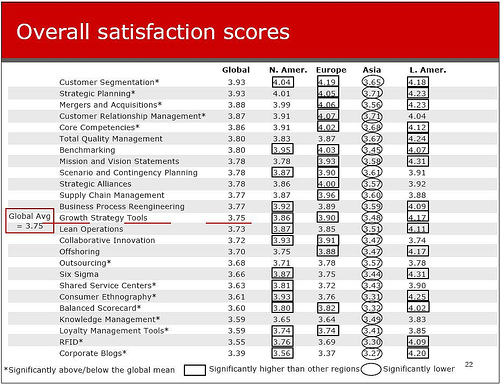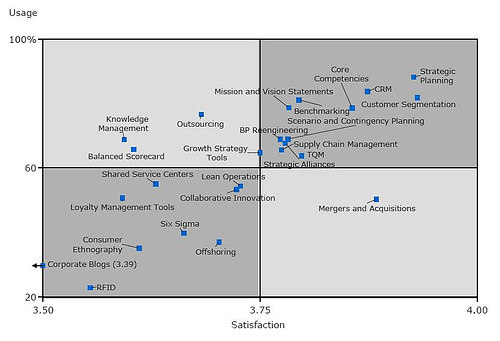Bain and Company recently published their Benchmarking Management & Tools 2007 Survey, which is a benchmarking study showing Executive Satisfaction Survey on Lean Six Sigma Programs. In that survey, both Lean and Six Sigma are included as part of the management tools used by companies. What is interesting are the satisfaction rates of those tools, as reported by the executives that completed the survey.
Below are some data collection heuristics:
In 1993, Bain launched a multi-year research project to get the facts about management tools and trends. Our objective is two-fold:
- To provide managers with information they need to identify and integrate tools that will improve bottom-line results
- To understand how global executives view their strategic challenges and priorities
Over the past 14 years, we have completed 11 surveys, assembling a database that now includes 8,504 respondents from more than 70 countries in North America, Europe, Asia, Africa, the Middle East and Latin America. This year, we received 1221 completed surveys from a broad range of international executives. We also conducted personal follow-up interviews to further probe the circumstances under which tools are most likely to produce desired results.
This year, we focused on 25 of the most popular tools and techniques, listed on the slide below. To qualify for inclusion, a tool had to be:
- Relevant to senior management
- Topical (as evidenced by coverage in the business press)
- Measurable
Perception and Satisfaction of Lean Manufacturing
Below is Bain’s explanation of Lean Manufacturing:
Lean Operations is both a methodology and philosophy that focuses on eliminating waste and reducing the time between a customer’s order and delivery. By trimming waste, companies — manufacturers of goods and providers of services alike — can achieve higher quality, increased productivity, improved customer interactions and speed. The goal of Lean Operations is to get the right things to the right place, at the right time, in the right quantities, while minimizing waste. The Lean concept was pioneered by Toyota founder, Taiichi Ohno, as a much faster, better and less-expensive way of producing vehicles. Lean Operations redefines waste as anything the customer won’t pay for — everything from clerical errors to idle machine operators. The process identifies seven types of waste:
- Waiting”for products, personnel, parts, the availability of machines;
- Transportation time”for equipment and parts needed for repairs;
- Processes”duplicate data entry, inefficient stocking;
- Excessive inventory;
- Unnecessary motion by people and machines;
- Overproduction;
- Correction of defects or service errors.
There are three key elements in Lean Operations:
- ensuring that the product flows through production without interruption;
- systems that replenish supplies and products in response to customer demand;
- and a culture that strives for both excellence and continuous improvement.
Five basic steps are used to improve the process flow:
- Identify activities that create value;
- Determine the major steps to deliver that value;
- Eliminate activities that do not add value;
- Ensure that products are available when consumers want them;
- Continuously improve processes.
While the Lean approach originally was designed for manufacturers, a broad range of industries now use the Lean concept to improve both operations and customers’ experience by:
- Spending less on equipment;
- Redesigning factories, stores and processes to increase efficiency of workers and machines;
- Reducing the number of workers needed to accomplish a task;
- Increasing efficiency of inventory stocking and replenishing;
- Improving customer service;
- Creating varied store formats;
- Developing branding — win customers by having cheaper prices, faster service or wider product selection.
Given the data heuristics and Bain’s definition of lean, below are some highlights on the satisfaction scores — or, executives satisfaction and perception of Lean:
- Globally, 2006 usage is 54% and 2006 overall satisfaction is (3.73 / 4.0), below of global satisfaction mean of 3.75.
- Lean is used by companies with revenues ranging from (< $600M to > $2B).
- In North America, 59% reported using Lean as a tool or methodology, 52% in Europe, 33% in Latin America, and 56% in Asia.
- Defection Rate: Defection is a measurement of loyalty, which shows the percentage that stopped using the tool in 2006 after using it at least once in the past five years. The global average defection rate was 5.7%. Defection of Lean is 2%, well below the global defection average.
Perception and Satisfaction of Six Sigma
Below is Bain’s explanation of Six Sigma:
Sigma is a measure of statistical variation. Six Sigma indicates near perfection and is a rigorous operating methodology aimed to ensure complete customer satisfaction by ingraining a culture of excellence, responsiveness and accountability within an organization. Specifically, it requires the delivery of defect-free products or services 99.9997 percent of the time. That means that out of a million products or service experiences, only 3 would fail to meet the customer’s expectations. (The average company runs at around Three Sigma, or 66,800 errors per million.)
To raise operations and product designs to the highest benchmark, Six Sigma programs constantly measure and analyze data on the variables in any process, then use statistical techniques to understand what improvements will drive down defects. Such programs also incorporate a strong system for gathering customer feedback. Companies have applied Six Sigma to functions ranging from manufacturing to call centers to collections. Some companies estimate that the Six Sigma methodology has helped them realize savings upwards of $1 billion.
Six Sigma entails five key steps:
- Define. Identify the customer requirements, clarify the problem and set goals;
- Measure. Select what needs to be measured, identify information sources and gather data;
- Analyze. Develop hypotheses, identify the key variablesand root causes;
- Improve. Generate solutions and put them into action, either modifying existing processes or developing new ones. Quantify costs and benefits;
- Control. Develop monitoring processes for continued high-quality performance.
Companies use Six Sigma to set performance goals for the entire organization and mobilize teams and individuals to achieve dramatic improvements in existing processes. More specifically, Six Sigma can:
- Make processes more rigorous by using hard, timely data, not opinions or gut feeling, to make operating decisions;
- Cultivate customer loyalty by delivering superior value;
- Strengthen and reward teamwork by aligning employees around complex processes whose performance can still be easily, clearly and empirically measured;
- Accustom managers to operating in a fast-moving internal business environment that increasingly mirrors marketplace conditions outside the company;
- Achieve quantum leaps in product performance;
- Reduce variation in service processes, such as the time from order to delivery, or offering a consistent, high-quality service experience;
- Improve financial performance, through cost savings from projects, increased revenue from improved products and expanded operating margins.
Here are the satisfaction highlights:
- In 2006, global usage was 40%, and a satisfaction rating of (3.66 / 4.0), below the global satisfaction mean of 3.75.
- Six Sigma is used by companies with revenues ranging from (< $600M to > $2B).
- 2006 usage: North America, 40%; Europe, 28%; Asia, 48%; Latin America, 30%.
- Defection Rate: Defection is a measurement of loyalty, which shows the percentage that stopped using the tool in 2006 after using it at least once in the past five years. The global average defection rate was 5.7%. Defection of Six Sigma is 6%, above the global defection average.
Below is a chart showing the tools surveyed and the satisfaction scores:

Here is a peception map, showing Usage against Satisfaction Rates:

Conclusion
If we find the integrity of Bain’s data to be sufficiently strong, then it’s clear that Six Sigma is losing favor in both usage and satisfaction. A 2006 defection rate of 6% (above the defection mean) and a satisfaction score of 3.66, (below the mean) is emerging evidence that executives from different industries and company sizes have a declining perception of Six Sigma.
On Lean, defection is at 2%, below the mean and satisfaction is slightly below the mean 3.73 (mean is 3.75).
For me, the data shows the propensity for companies to tout “flavor-of-the-day” tools, methodologies, and initiatives that likely be abandoned at a later time, as evidenced by the mean defection rate.
What does this mean for those of us who are practitioners and supporters of Lean and Six Sigma? I believe to increase satisfaction, we must show results. It is ridiculous and not pragmatic to hold Lean or Six Sigma at a religious status, as some might be accused of doing. Tool, method, or system fanaticism to the side, we must show results.
At the end of the day, executives and others will judge a methodology or tool or system by what it has done for them and for the firm. True, Lean is a system that must be practiced as a system in order to wholly benefit from it. For companies not mature or ready to fully understand that concept, it might make sense to slowly immerse them in Lean, and that might be done tool by tool, method by method; not as a whole system immediately. Similarly for Six Sigma.
Results. Lean and Six Sigma must show results. How has the firm saved money, time, or resources? How has the firm opened new markets and increased revenue? Is the customer more delighted than she once was post implementation of Lean or Six Sigma? We must keep our eye on showing and demonstrating results that are beneficial to the firm. That is the only way satisfaction rates will recover from their declining trajectory.
Data Source: Bain Management and Tools 2007 Survey









Wow, what an excellent post Pete. I think you hit the nail on the head when you spoke about results. As I have mentioned a few times on my blog and to you via email… all the labels placed on continuous wear me out. In the end I don’t care if you are a green belt, black belt, or lean super kung fu master… make my business better and I love you. Stand around do nothing and Houston we have a problem. The funny thing is I am preparing to make a post tonight about all these surveys. They are beginning to wear me out since in most cases all we are seeing in the “trends” is common cause variation. But just because we saw a dip of .023% on some key criteria these business consultants get their panties in an uproar.
Hello,
I like your blog 🙂 … but I don’t like the marketing hype around six sigma. It makes a disservice to the genuine philosophy of Deming/Shewhart Statistical Process Control.
I explain why on my blog:
http://statistical-process-control.blogspot.com/2007/11/six-sigma-critics.html